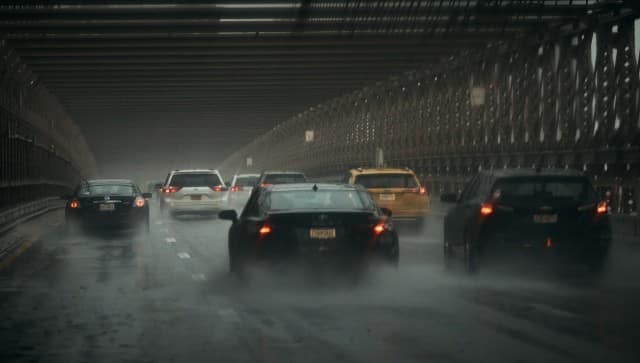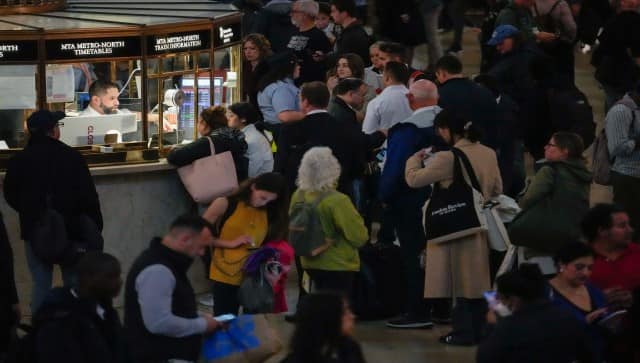New York is experiencing one of the wettest days in decades after heavy rainfall overwhelmed the American city’s sewer system on Friday. The record-setting rain knocked out several subway and commuter rail lines, stranded drivers on highways, flooded basements and shuttered a terminal at LaGuardia Airport for hours. A state of emergency is currently in effect for the city’s 8.5 million citizens as well as those residing in Long Island, the Hudson River Valley, and surrounding suburbs. Here’s all we know about the situation. Also read: New York is sinking, and some iconic places in the city are going down faster Record-breaking rainfall Some 8.65 inches (21.97 centimetres) of rain had fallen at New York’s John F. Kennedy Airport by nightfall Friday, surpassing the record for any September day set during Hurricane Donna in 1960, The Associated Press quoted National Weather Service as saying. Parts of Brooklyn saw more than 7.25 inches (18.41 centimetres), with at least one spot recording 2.5 inches (6 centimetres) in a single hour, according to weather and city officials. [caption id=“attachment_13188622” align=“alignnone” width=“640”] A man works to clear a drain in flood waters, in the Brooklyn borough of New York. AP[/caption] The sewage infrastructure in the city was only intended to manage 1.75 inches per hour, according to New York’s top climate officer Rohit Aggarwala. “It’s no surprise that parts of Brooklyn have borne the brunt of this,” BBC quoted him as saying. More downpours were expected on Saturday. The deluge came two years after the remnants of Hurricane Ida dumped record-breaking rain on the Northeast and killed at least 13 people in New York City, mostly in flooded basement apartments. Although no deaths or severe injuries have been reported, Friday’s storm stirred frightening memories.
New York: The rain isn’t over yet. It is extremely dangerous to travel on flooded streets.
— Governor Kathy Hochul (@GovKathyHochul) September 29, 2023
As rain continues to impact downstate areas throughout the day, don’t attempt to walk, bike, or drive in these conditions.
Stay safe. pic.twitter.com/gGeCShKR87
State of emergency declared City officials said they received reports of six flooded basement apartments Friday, but all occupants got out safely. Governor Kathy Hochul and Mayor Eric Adams declared a state of emergency and urged people to stay put if possible. “This is a dangerous, life-threatening storm,” Governor Kathy Hochul said. “I am declaring a state of emergency across New York City, Long Island, and the Hudson Valley due to the extreme rainfall we’re seeing throughout the region,” Gov Hochul said on X (formerly Twitter).
I am declaring a State of Emergency across New York City, Long Island, and the Hudson Valley due to the extreme rainfall we’re seeing throughout the region.
— Governor Kathy Hochul (@GovKathyHochul) September 29, 2023
Please take steps to stay safe and remember to never attempt to travel on flooded roads.
Mayor Eric Adams urged people to stay inside their homes. “If you are home, stay home. If you are at work or school, shelter in place for now, some of our subways are flooded and it’s extremely difficult to move around the city,” he said. Hoboken, New Jersey, and other cities and towns near New York City also experienced flooding. New Jersey governor Phil Murphy called for state offices to close at 3 pm, except for essential personnel. [caption id=“attachment_13188662” align=“alignnone” width=“640”] Pedestrians walk along a flooded sidewalk, Friday, in the Brooklyn borough of New York. AP[/caption] A state of emergency was also declared in the New Jersey town of Hoboken, just across the Hudson River from New York City. But schools were open, students went to class and many adults went to work, only to wonder how they would get home. Subway and bus services affected Virtually every subway line was at least partly suspended, rerouted or running with delays. Metro-North commuter rail service from Manhattan was suspended for much of the day but began resuming by evening. “Some of our subways are flooded and it is extremely difficult to move around the city,” Adams told a press briefing. The Long Island Rail Road was snarled, 44 of the city’s 3,500 buses became stranded and bus service was disrupted citywide, transit officials said. [caption id=“attachment_13188602” align=“alignnone” width=“640”]
 Cars move along Brooklyn Bridge under heavy rain on Friday in Brooklyn borough of New York. AP[/caption] “When it stops the buses, you know it’s bad,” Brooklyn high school student Malachi Clark said after trying to get home by bus, then subway. School buses were running, but they transport only a fraction of public school students, many of them disabled. A long line of people snaked from the ticket counter in the afternoon at Grand Central Terminal, where Mike Tags was among those whose trains had been cancelled. Railroad employees had suggested possible workarounds, but he wondered whether they would work out. “So I’m going to sit here, ride it out, until they open up,” he said. [caption id=“attachment_13188632” align=“alignnone” width=“640”]
Cars move along Brooklyn Bridge under heavy rain on Friday in Brooklyn borough of New York. AP[/caption] “When it stops the buses, you know it’s bad,” Brooklyn high school student Malachi Clark said after trying to get home by bus, then subway. School buses were running, but they transport only a fraction of public school students, many of them disabled. A long line of people snaked from the ticket counter in the afternoon at Grand Central Terminal, where Mike Tags was among those whose trains had been cancelled. Railroad employees had suggested possible workarounds, but he wondered whether they would work out. “So I’m going to sit here, ride it out, until they open up,” he said. [caption id=“attachment_13188632” align=“alignnone” width=“640”] Commuters are seen on a Hudson line train waiting to depart Grand Central Terminal, Friday. AP[/caption] Traffic hit a standstill earlier in the day on a stretch of the FDR Drive, a major artery along Manhattan’s east side. With water above car tires, some drivers abandoned their vehicles. On a street in Brooklyn’s South Williamsburg neighbourhood, workers were up to their knees in water as they tried to unclog a storm drain while cardboard and other debris floated by. Some people arranged milk crates and wooden boards to cross flooded sidewalks.
Commuters are seen on a Hudson line train waiting to depart Grand Central Terminal, Friday. AP[/caption] Traffic hit a standstill earlier in the day on a stretch of the FDR Drive, a major artery along Manhattan’s east side. With water above car tires, some drivers abandoned their vehicles. On a street in Brooklyn’s South Williamsburg neighbourhood, workers were up to their knees in water as they tried to unclog a storm drain while cardboard and other debris floated by. Some people arranged milk crates and wooden boards to cross flooded sidewalks.
New York City subway pic.twitter.com/yigWMFx1nA
— Build Wealth to buy Freedom (@wealthXfreedom) September 30, 2023
A Brooklyn school was evacuated because its boiler was smoking, possibly because water got into it, Schools Chancellor David Banks said. Another Brooklyn school was mopping up ground-floor classrooms, City Councilwoman Crystal Hudson said in an email seeking volunteers to help. While speaking to CBS, Adams revealed there had been three basement flat rescues and 15 car rescues. [caption id=“attachment_13188682” align=“alignnone” width=“640”] A school bus drives through heavy flooding in the New York City suburb of Larchmont, New York. Reuters[/caption] Also read: Explained: Why New York is sinking under its own weight Flights cancelled Travelling via plane wasn’t any better. On Friday, there were delays at all three airports in the New York City area. Flights into LaGuardia were briefly halted in the morning, and then delayed, because of water in the refuelling area. Flooding also forced the closure of one of the airport’s three terminals for several hours. Terminal A resumed normal operations around 8 p.m. It was suggested that travellers check with their airline before departing. Hockey game postponed The New York Rangers and New York Islanders postponed a preseason hockey game on Long Island. [caption id=“attachment_13188642” align=“alignnone” width=“640”]
In this image taken from video, a section of the FDR Drive sits submerged in flood waters, Friday, in New York. AP[/caption] And at the waterlogged Central Park Zoo, a sea lion swam out of her swollen pool. With the zoo closed because of the weather, she looked around for a bit before returning to the pool, zoo officials said in a statement. Also read: What are flash floods that are wreaking havoc in Himachal Pradesh? The reason for so much rain The remnants of Tropical Storm Ophelia over the Atlantic Ocean combined with a mid-latitude system arriving from the west, at a time of year when conditions coming off the ocean are particularly juicy for storms, National Weather Service meteorologist Ross Dickman said. This combination storm parked itself over New York for 12 hours. The weather service had warned of three to five inches (7.5 to 13 centimetres) of rain and told emergency managers to expect more than six inches (15 centimetres) in some places, Dickman said. [caption id=“attachment_13188652” align=“alignnone” width=“640”]
In this photo taken from video, work in flood waters to clear drains on a street, Friday, in the Brooklyn borough of New York. AP[/caption] The deluge came less than three months after a storm caused deadly floods in New York’s Hudson Valley and swamped Vermont’s capital, Montpelier. According to CNN, scientists believe the high totals are a sign of climate change because a warmer atmosphere acts like a giant sponge, able to absorb more water vapour and then squeeze it out in powerful spurts that are readily capable of overwhelming antiquated flood defences. “Overall, as we know, this changing weather pattern is the result of climate change. And the sad reality is our climate is changing faster than our infrastructure can respond,” Rohit Aggarwala, New York City’s Chief Climate Officer said in a Friday morning news conference. In the case of Friday’s storm, nearby ocean temperatures were below normal and air temperatures weren’t too hot. Still, it became the third time in two years that rain fell at rates near two inches (five centimetres) per hour in Central Park, which is unusual, Columbia University climate scientist Adam Sobel said. The park recorded 5.8 inches (14.73 centimetres) of rain by nightfall Friday. [caption id=“attachment_13188672” align=“alignnone” width=“640”]
 An MTA employee helps commuters as train service as been disrupted due to heavy rains at Grand Central Terminal information booth. AP[/caption] What to expect next A flood watch is in place for the whole tri-state region as a result of the forecast for continued heavy rain and flooding through Saturday morning, according to Hindustan Times. Before the storm passes, one to two inches of rain per hour are expected to fall on average, with some places anticipating as much as five to eight inches. Serious floods and flash flooding situations are likely due to the saturated soil from earlier rain. With inputs from agencies
An MTA employee helps commuters as train service as been disrupted due to heavy rains at Grand Central Terminal information booth. AP[/caption] What to expect next A flood watch is in place for the whole tri-state region as a result of the forecast for continued heavy rain and flooding through Saturday morning, according to Hindustan Times. Before the storm passes, one to two inches of rain per hour are expected to fall on average, with some places anticipating as much as five to eight inches. Serious floods and flash flooding situations are likely due to the saturated soil from earlier rain. With inputs from agencies


)

)
)
)
)
)
)
)
)



